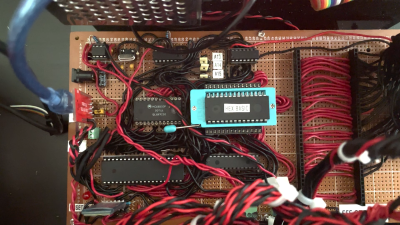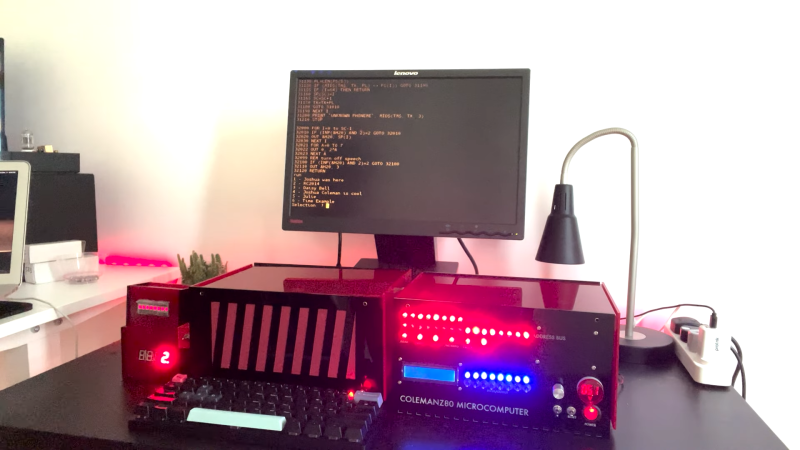[Joshua Coleman] likes to design his own computers. Sometimes, that means drawing up bus architectures, memory maps and I/O port pinouts. Other times, he can focus his efforts more on the general aesthetics, as well as on building a great set of peripherals, as he shows in his latest ColemanZ80 project. Thanks to the RC2014 architecture defining most of the essential features of a classic Z80 computing platform, [Joshua] was able to design a modern retrocomputer that’s not only genuinely useful, but also looks as if it came off a production line yesterday.
The external design is a sight to behold: bright red laser-cut acrylic pieces form a neat, semi-transparent case with ventilation slots on the sides and lots of blinkenlights on the front. Inspired by 1970s classics like the Altair 8800, the front panel gives the user a direct view of the machine’s internal state and allows simple command inputs through a series of tumbler switches. The CPU, RAM and other basic devices are housed in one case, with all the expansion modules in a second one, linked to the mainboard through a 40-wire flatcable.

Although the mainboard closely follows the RC2014 design, [Joshua] went through a lot of effort to tune the system to his specific needs. The expansion boards he built include an NS16550 UART to replace the default 68B50, a battery-backed real-time clock, a YM2149-based sound card and even a speech synthesizer module built around the classic SP0256 chip, of Speak & Spell fame. An even more unusual feature is the presence of an AM9511, one of the earliest math coprocessors ever made, to speed up floating-point calculations. All of these modules were built entirely by hand on prototype boards: we can barely imagine how much time this must have taken.
Output devices include a VGA adapter courtesy of a Raspberry Pi Pico as well as a regular 4-digit 7-segment LED display and a set of classic HP “bubble” LEDs. [Joshua] runs several demos in his video (embedded below), ranging from computing the Mandelbrot set to playing chiptunes on the YM2149. There’s plenty of scope for further expansion, too: [Joshua] plans to build more peripherals including a floppy drive interface and a module to operate a robotic car.
This is not the first Coleman Z80 computer: the previous version ran on an architecture [Joshua] designed all by himself. We’ve seen several other impressive RC2014 derivatives, like a tiny micro version and this Altair-inspired case.















Cool project – indeed, impressive machine, expansion cards, and wiring (!), but I would recommend turning this into a proper PCB for reliability. On a nitpick, “SP0256, of Speak & Spell fame” is a bit misleading though, as TI used their own LPS-based speech chip – the TMC0280. This one sounds very different from the allophone / phoneme-based SP0256, and is much more versatile.
As the creator of the video and the Colemanz80, I will amend the description to include this information. Not a nitpick at all! Gotta stay accurate. I was lead to believe but didn’t really do much digging. Thanks for cleaning that up for me.
Built your own computer, then used a computer far more powerful than it just for video output. :)
TI’s chip was LPC — Linear Predictive Coding, and used a customised DSP to play back encoded phrases. TI was big on LPC using their TMS320 general purpose DSP chip. However, you needed LPC encoder and decoder firmware to do that, which, at the time, wasn’t easily available. LPC is a very cool method of reproducing speech, though. It’s worth a Google.
SP0256 was from General Instrument, and was, as you said, formant-based. We used it on a ham repeater controller I helped to design, because it could speak out any string of formant codes you put together. It was also available at Radio Shack for something like $12, and very simple to hook up.
No blue LEDs in the 1970s! They were used asan April Fool’s joke at the time. 😎
Yellow and green ones would have been the hotness in ’79
IIRC, that was the DED — the Dark Emitting Diode.
I have a number of DED laying around. They are fairly easy to make yourself.
Same with write-only memory.
Let us not forget the NED — the Noise Emitting Diode.
Fun fact… many LEDs become NEDs above 50 volts or even lower… if you omit the current-limiting resistor.
I thought those were BEDs – Bang-Emitting Diodes?
SED
Smoke emitting diodes
Very impressive! 😃
Brings back memories: I bought an SPO256 in the 80s and interfaced it to my TRS80 Model III’s expansion bus. Hours of fun making cool robotic speech.
I’m a hardware guy like Joshua, but with some programming experience. My thinking here is that it would be mo’ betta’ to take the final step. He already had to adapt the OS for the Math Co, so why not just move to a more powerful processor. Especially moving to the ability to address more than 64 kB of memory.